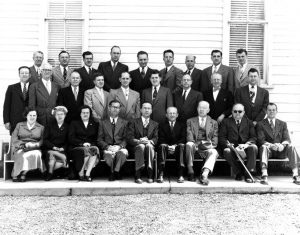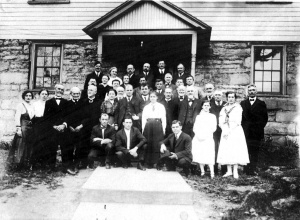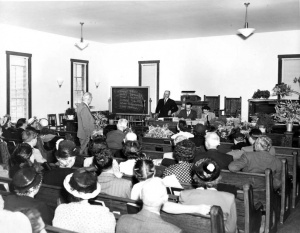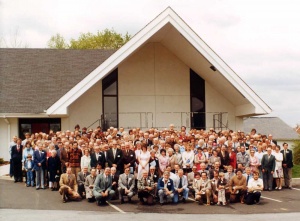Eastern District Conference (Mennonite Church USA)
1956 Article
During the second quarter of the 19th century great changes entered into American religious life. A resurgence of revivalism and evangelical fervor broke through widespread deadness in many denominations. Throughout the country, home and foreign mission boards, tract and temperance societies, church colleges and seminaries, religious literature and periodicals, and Sunday schools were founded.
The Mennonites of the Franconia Conference (MC) in southeastern Pennsylvania, in spite of their attempted isolation, also felt the impact of this new religious environment, with its new visions of opportunity and responsibility. Locally the Pennsylvania Public School Law of 1834, with its emphasis on the English language and American cultural patterns, had a profound, though quiet, influence upon traditionally minded German Mennonites, especially those of the younger generation.
In the 1840s some of the younger ministers of the Franconia Conference, including John H. Oberholtzer of Swamp and Abraham Hunsicker of Skippack, manifested a more progressive spirit in church matters. Oberholtzer, a gifted schoolteacher and skilled locksmith, became a fervent preacher and student of the Scriptures. He organized children's meetings, printed a catechism, preached in other denominations, and refused to wear the regulation minister's coat. Because of this latter act, he and several like-minded ministers were excluded from the conference meeting in 1844. In seeking to be reinstated soon after, Oberholtzer became deeply impressed with the lack of proper procedure in conference. With no secretary, no minutes, no business nor voting procedure, irregularities were bound to occur in the applications of the old, unwritten church rules.
In the spring of 1847 Oberholtzer, encouraged by Abraham Hunsicker, drafted a conference constitution, which was unofficially accepted by a like-minded group of 16 ministers and deacons. On the following day at the spring conference Oberholtzer appeared, dressed in a regulation coat, to present his constitution, but was denied the opportunity to read it. The constitution was later printed and distributed among the ministers. At the fall conference the sponsors again appeared, asking for a committee to study the constitution. In the end, however, the conference adopted a vigorous resolution excommunicating all signers of the constitution unless they renounced it; if they did so they again would be received in love. That such controversy could occur between sincere brethren is indeed lamentable, especially since the issues involved concerned not the major doctrines of the church but rather new methods of promoting and preserving the old Gospel.
On 28 October 1847, three weeks after the decision of the conference, the signers of the new constitution met at the Skippack meetinghouse to consider their future course. After due consideration of the conference resolution favoring the "old evangelical order," they decided that such would be conscientiously impossible. Thereupon, they adopted the new constitution, and the name, "The East Pennsylvania Conference of the Mennonite Church." This Skippack meeting marks the official founding of the present Eastern District Conference.
Those who attended this historic meeting were John Hunsicker, William Landis, John H. Oberholtzer, Abraham Hunsicker, Christian Clemmer, and Joseph Schantz, as ministers, and William Gottschall, John Detweiler, Henry B. Shelly, Jacob Benner, and Samuel Kaufman, as deacons. These men represented the entire congregations of West Swamp, East Swamp, Flatland, Skippack, Schwenksville, Upper Milford, Germantown, and Bertolet's; and elements of the congregations of Worcester, Providence, Rockhill, Saucon, Springfield, Boyertown, and Hereford. The Deep Run congregation was not represented at this meeting because the division there was purely a laymen's movement. Some of the signers were absent from this meeting. All in all, the new conference started with 8 ministers, 11 deacons, and 16 congregations, totaling about 500 members, or one fourth of the Franconia Conference. Of the 70 ministers and deacons in the Franconia Conference at that time, 16 withdrew including John Hunsicker, the senior bishop of the conference, one of the five bishops functioning at that time.
John H. Oberholtzer's constitution adopted by the new conference reveals that the aims of this group were not radical, but substantially followed traditional Mennonite doctrine and polity. The method and approach, however, were new. The early activities of the East Pennsylvania Conference verified this progressively traditional policy. The traditional forms of worship and vigorous discipline were continued alongside of such innovations as children's meetings and Sunday schools in the 1850s, a conference Sunday-school union in 1876, a religious periodical, the Religiöser Botschafter, in 1852, the inward calling of ministers, ministerial support, pulpit fellowship with other denominations, and limited open communion.
A survey of the beginnings of religious groups in church history frequently reveals that the greater the birth pangs, the greater will be the growing pains. The East Pennsylvania Conference was no exception; its growing pains were severe. In 1851, the Hunsickers (John and Abraham) were excommunicated for advocating tolerance toward secret societies and more liberal interpretation of open communion than conference was willing to accept. In the middle 1850s, the emotional religion and revivalism of the Methodist style began to penetrate the northern congregations in the form of prayer meetings. Matters came to a climax in 1858 when William N. Shelly, William Gehman, and five other ministers withdrew and formed the Evangelical Mennonite Conference, one of the groups which later formed the Mennonite Brethren in Christ. The third and last controversy centered at Skippack over feetwashing. This congregation, demanding the literal interpretation of this rite, and refusing to agree with the conference's spiritual interpretation, seceded in 1859 to become an independent congregation (called popularly the Johnson Mennonite Church, because the leader and most of the ministers after him had that name). The first two of these controversies reveal that conference was unwilling to accept either a weakened liberalism or a radical revivalism, though in so rejecting them it lost both the educated Hunsickers and men of evangelistic fervor. The last controversy, on the other hand, reveals the liberal spirit of conference as opposed to the more literal spirit of the minority, though again the fellowship of a strong congregation was lost to the young and struggling conference.
Following the organization of the East Pennsylvania Conference, John H. Oberholtzer vigorously championed a greater unification of Mennonites all over America. The East Pennsylvania Conference was also much interested in this movement, and in 1860 delegated Oberholtzer and Enos Loux to go to a church unification meeting at West Point, Iowa. At that historic meeting with Oberholtzer in charge, the General Conference was organized to include the East Pennsylvania congregations and the Iowa congregations. In a short time the congregations of like-minded brethren in Canada, Ohio, and Illinois joined this unification movement.
Publication activities continued through the years. Minutes, catechisms, reports, Sunday-school literature, and other papers were printed by conference at Milford Square. The Religiöser Botschafter became Das Christliche Volksblatt in 1856 and the Friedensbote in 1867, which in 1882 was merged with a western paper to become the General Conference's German periodical, Der Christliche Bundesbote, now Der Bote. In 1885, N. B. Grubb and Allen M. Fretz, with the approval of conference, founded The Mennonite, which became the General Conference English periodical. In 1895, conference published the first Mennonite Yearbook and Almanac, which later became the official conference yearbook. The Conference always had an active home mission program. Congregations organized by the Conference were Wadsworth, Ohio, in 1852; and in Pennsylvania Bowmansville in 1852, First Philadelphia in 1865, Souderton in 1893, Pottstown in 1895, Quakertown in 1899, Allentown in 1903, Perkasie in 1905, Lansdale in 1929, and Lancaster in 1946. During the first half of the 20th century years a group of congregations and missions were added in central Pennsylvania (Fairfield, Richfield, Roaring Spring, etc.) and Stirling Avenue at Kitchener, Ontario.
In the 1890's, Christian Endeavor societies were organized in many of the congregations, and were soon after followed by the organization of a conference Young People's Union. In 1928 a young people's retreat was organized, which after 1941 were held at Men-O-Lan Retreat Grounds near Finland, Pennsylvania owned and operated by the conference. In 1896 a home for the aged was begun at Frederick, Pennsylvania. A brotherhood organization for laymen was organized in 1918. An orphanage society and a women's organization were active for many years. In many of these ventures the Eastern District Conference pioneered among American Mennonites.

Row 1 (L-R): 1. Elizabeth Hirschy, 2. Wilhelmina Kuyf, 3. Leona Cressman, 4. Ward W. Shelly, 5. Walter McDowell, 6. Wilmer S. Shelly, 7. Unknown, 8. John J. Esau (Grace Bible Institute), 9. Randall Heinrichs;
Row 2: 1. Arthur S. Rosenberger, 2. Elmer Hess, 3. John J. Plenert, 4. Maynard Shelly, 5. Leon Detweiler, 6. Wilmer B. Denlinger, 7. Dr. S. Floyd Pannabecker (Mennonite Biblical Seminary), 8. Freeman H. Swartz, 9. J. Walter Dick;
Row 3: 1. P. K. Regier, 2. Ellis Graber, 3. Wilfred D. Ulrich, 4. Curtis C. Bedsworth, 5. Curtis Lehman, 6. J. Herbert Fretz, 7. Harry Yoder (Bluffton College), 8. Abe H. Schultz, 9. Harold Feerrar.
According to the constitution, the Conference was made up of congregations which "taking the Sacred Scripture of the Old and New Testament as the only and infallible rule of faith and life, hold fast to the doctrine of salvation by grace through faith in the Lord Jesus Christ, and in their teaching and practice adhere to the Mennonite principles of administering baptism only on confession of faith, avoiding the use of all oaths, a life of meekness, peace, and Biblical inoffensiveness, and the practice of a Scriptural church discipline to the end of separating from the communion of believers the unrepentant and incorrigible transgressors against the laws of God."
Most of the controversial activities and methods early promoted by the Eastern District Conference were later accepted by the great body of Mennonites. The Eastern District Conference still differed in the 1950s from more conservative Mennonites in such things as the absence of detailed church rules, the absence of a prescribed religious garb, the use of a trained and supported ministry, a wider denominational fellowship, and open communion.
The 100th anniversary of the Eastern District Conference was observed in the historic Lower Skippack meetinghouse, with appropriate meetings on 26-28 October 1947. The first issue of a conference periodical, The Messenger, was published at that time.
In 1956 the conference had 4,558 members in 28 congregations, with 25 active ministers and 52 deacons. -- J. Herbert Fretz
1990 Article
The Frederick Home and Camp Men-O-Lan ministries greatly expanded after the 1950s. The Home now included enlarged nursing facilities, a number of residential cottages for older people, a community center, and more low-income apartments in the planning stage. The administrator in 1987 was Robert W. Miller. Camp Men-O-Lan, with Ray Linberger as administrator, had a year-round program of camping and retreats for all ages. The conference quarterly, The Messenger, under former editors Marjorie Geissinger and Curtis D. Bauman; had, by 1987, grown to include more news and articles from the congregations and people of the conference, the General Conference Mennonite Church, and Franconia Conference (MC).
A new effort toward coordination in the conference was made when a conference minister was appointed in 1982 in the person of David Hillegas. During the second half of the 20th century church planting was undertaken in lower Bucks County, Germantown, and elsewhere. The conference began work among Hispanic people in 1958 in Lansdale. An important inner city outreach ministry called Crossroads was active in North Philadelphia, including a community center, a food pantry, a prison ministry, 4-H clubs, and garden projects.
Perhaps most significant has been a growing cooperation with the sister Franconia Conference of the Mennonite Church, in such projects as the Germantown Church congregation and corporation, the Mennonite Heritage Center in Souderton, the Mennonite Historians of Eastern Pennsylvania, and the publication in 1984 of "a narrative account of life in the oldest Mennonite community in North America," a joint history of the Franconia Conference and the Eastern District Conference (Ruth, Maintaining). Since the division of 1847 both conferences side-by-side had gone their separate ways, each continuing to meet in conference the first weekend in May. By the 1980s they began to meet together on the first Sunday evening in May at the end of their individual meetings to sing and pray together. On Friday evening, 2 May 1986, they finally met together in conference at the Deep Run (East) congregation to consider their several common projects—the first such session in 139 years! In 1986 the conference had 4,589 members in 27 congregations with 30 active ministers. -- J. Herbert Fretz
2010 Update
The 1980s and 1990s were a time of increasing divisive tendencies, tension, and conflict for the oldest area conference in the former General Conference Mennonite Church. The congregations in the General Conference had historically had more congregational autonomy than those in the larger (Old) Mennonite Church. This autonomy created a more favorable climate in which to be influenced by their surrounding church culture. Unfortunately this weakened their Anabaptist beliefs and created feelings of separation and distance from the General Conference, especially the colleges and seminaries. Some congregations called pastors from non-Mennonite denominations and theological backgrounds, which opened the way for Fundamentalism to shape some Eastern District congregations. This trend gathered momentum during the last half of the 20th century.
An early dispute in the 1980s was whether the Conference should approve the ordination of women to ministerial leadership. This was greatly highlighted when the Fairfield congregation asked the Conference Ministerial Committee to ordain Joyce M. Shutt, a life-long member of the congregation and their pastor. When the Ministerial Committee declined to do so the congregation had a pastor from the Western District Conference perform the ordination on Sunday, 18 May 1980. A special conference session held at Zion Mennonite Church in Souderton in the spring of 1981 failed to find agreement on this issue.
Throughout the 1990s tensions became more apparent. The Conference leadership was moving further away from the basic tenets of the Mennonite faith. One issue was the new “Confession of Faith in a Mennonite Perspective” that was in process during the first half of the decade. Some Eastern District pastors took issue with specific wording regarding the ordination of women and the infallibility of scripture. Following the General Conference sessions at Wichita in 1995, where the Confession was adopted, a number of Eastern District congregations and leaders continued to voice their dissent. Other contentious issues included human sexuality, the peace position, the deity of Jesus and the proposed integration of the General Conference Mennonite Church and the Mennonite Church.
The ongoing question of how do we understand the scriptures, or the word infallibility, appeared to be unending. This word was insisted upon as being necessary because it appeared in all previous General Conference Mennonite Church statements of faith. A conference session focusing on that question was held at Camp Men-O-Lan on 26 September 1998. The session ended in an even wider separation with threats of division among the congregations. Shortly thereafter the pastors and leaders who were unhappy with the new Confession of Faith met on 14 November 1998 at Indian Valley Mennonite Church in Harleysville. This meeting formed the Association of Mennonite Evangelical Congregations, which became known as AMEC. When AMEC formed an alliance with congregations outside of the Eastern District in 2002, the name was changed to Alliance of Mennonite Evangelical Congregations. Nine congregations from the Eastern District Conference became part of this new structure including East Swamp Mennonite, Quakertown; Grace Bible Fellowship, Huntingdon Valley; Hereford Mennonite, Bally; Indian Valley Mennonite, Harleysville; Pine Grove Mennonite, Bowmansville; Saucon Mennonite, Coopersburg; Second Mennonite, Philadelphia; Springfield Mennonite, Pleasant Valley; and United Mennonite, Quakertown. Robert Gerhart, pastor of the Hereford congregation in Bally, emerged as the leader and primary organizer of this group. In 2010 the Lower Skippack congregation also joined AMEC.
In 1997 the Germantown Mennonite Church, which maintained dual conference membership with both the Eastern District and the Franconia Conference, was removed from Franconia Conference membership for welcoming gay and lesbian members who were in same-sex covenanted relationships. Eastern District polity at the time prevented a similar action toward Germantown for being “at variance” with the Confession of Faith of 1995. That polity changed with the formation of Mennonite Church USA in 2001-2002, and a proposal to remove the Germantown congregation was put forth, hotly debated, and eventually passed the conference in November 2002.
As the proposed merger of the General Conference Mennonite Church and the Mennonite Church progressed, a special session of the Eastern District Conference was called on 18 March 2000 to discuss and vote on the nationwide proposal. Those opposed to the merger presented a motion that the Eastern District should not become members of Mennonite Church USA. The officers of the conference proposed that a two-thirds vote be required for passage. Those opposed to the passage argued for a simple majority vote but their objections were denied. After a lively debate the motion not to join was defeated by a vote of 114-104. The defeat of this motion meant that the Eastern District would become a member conference of Mennonite Church USA. Shortly thereafter all nine of the AMEC congregations as well as the Richfield and Lower Skippack congregations withdrew from the Eastern District.
In 1982 the Conference appointed David Hillegas, pastor of Saucon Mennonite Church, as its first Conference Minister to serve on a half-time basis. After serving for 13 years David resigned in early 1995, due to cancer from which he died on 31 March. Carlton Minnis, pastor of Second Mennonite Church in Philadelphia, was appointed Interim Conference Minister and served on a half-time basis, until Warren Tyson was appointed in December of 1998 while concurrently serving as Conference Minister in the Atlantic Coast Conference. Both David Hillegas and Carlton Minnis pastored congregations which withdrew from the Eastern District and joined the AMEC group.
The mission of Eastern District Conference since 2002 has been “Connecting Great Commission Congregations.” By 2010 the Eastern District Conference Missions Committee was encouraging and assisting a number of new church plants. Several new congregations have emerged, including a bilingual English-Spanish, a Spanish-speaking, a Haitian Creole/French speaking and an Asian-Indian congregation. In February 2009 the Eastern District Conference employed the services of a church planting coach and consultant one-fourth time to walk alongside new church plants in a variety of stages. In addition to church plants in eastern Pennsylvania, new church initiatives were centered in Maine, Massachusetts, and Connecticut. In 2010 the conference had one church plant younger than five years old for every two established churches.
Frederick Mennonite Community, the oldest Mennonite retirement community in the United States, continued to serve both conference and community retirees living in independent, assisted and skilled nursing facilities. The Executive Director in 2010 was John Hendrickson. Camp Men-O-Lan, the oldest Mennonite camp, operated year-round, offering a mix of camping experiences for all ages. The Executive Director in 2010 was Bryan Smith. Crossroads Community Center in Philadelphia continued to receive strong conference support. The Mennonite Heritage Center in Harleysville and the Germantown Mennonite Historic Trust in Philadelphia were jointly operated by the Eastern District and Franconia Mennonite Conferences. The Messenger, which began in 1947, was published bi-monthly and edited in 2010 by Karen Del’Marmol.
At the end of 1998, the Eastern District had 27 congregations with approximately 4,200 members. Between 1999 and 2002, the conference lost 11 congregations and nearly 2,000 members, most of whom withdrew because they did not wish to become members of Mennonite Church USA. Most of the congregations that withdrew participated in the formation of the Alliance of Mennonite Evangelical Congregations. In 2005 the Bethel Mennonite congregation in Lancaster and First Mennonite Church in Allentown closed their doors due to major drops in membership. Around this same time the Emmanuel Mennonite congregation in Reinholds transferred its membership from the Eastern District Conference to the Atlantic Coast Conference of MC USA. In October 2010 the Eastern District Conference was composed of 18 congregations, which included five church plants, 27 active ministers and chaplains, and 1,877 members located in Pennsylvania and Massachusetts. -- Ray K. Hacker with the assistance of James Amstutz, David Bartow, Joseph Miller, Warren Tyson, and Paul Wikerd.
2017 Directory
In 2017 the following congregations were members of the Eastern District Conference:
| Congregation | City | State |
|---|---|---|
| Christ Fellowship | Allentown | Pennsylvania |
| Church of the Good Samaritans | Holland | Pennsylvania |
| Cornerstone Community Church | Mifflintown | Pennsylvania |
| Deep Run West Mennonite Church | Perkasie | Pennsylvania |
| Eglise Evangélique Solidarité and Harmonie | Philadelphia | Pennsylvania |
| Fairfield Mennonite Church | Fairfield | Pennsylvania |
| Mennonite Congregation of Boston | Cambridge | Massachusetts |
| New Eden Fellowship | Schwenksville | Pennsylvania |
| Roaring Spring Mennonite Church | Claysburg | Pennsylvania |
| Upper Milford Mennonite Church | Zionsvlle | Pennsylvania |
| West Swamp Mennonite Church | Quakertown | Pennsylvania |
| Zion Mennonite Church | Souderton | Pennsylvania |
Bibliography
Gesch. der Trennung in 1847 und 1848 der Mennonite in Ost-Pennsylvanien. broadside, 1863. This was used as a basis for John Oberholtzer's testimony in the Boyertown court trial of 1883 (for an English translation see the Mennonite, 2 November 1922: 2).
The Messenger 1 (October 1947).
The Messenger of the Eastern District Conference, published quarterly. 1947-
Oberholtzer, J. H. Ordnung der Mennonitischen Gemeinschaft. 1847.
Oberholtzer, J. H. Der Wahre Character von J. H. Oberholtzer. Milford Square, PA, 1860.
Pannabecker, Samuel Floyd. Development of the General Conference of the Mennonite Church of N. A. in the American Environment. Manuscript, unpublished Yale doctoral dissertation, 1944.
Pannabecker, Samuel Floyd. Open Doors: History of the General Conference Mennonite Church. Newton, KS: Faith and Life, 1975.
Ruth, John L. Maintaining the Right Fellowship. Scottdale, PA: Herald Press, 1984.
Shelly, P. R. Religious Education and Mennonite Piety Among the Mennonites of Southeastern Pennsylvania 1870-1943. Newton, KS, 1952.
Supreme Court of Pennsylvania Eastern District—January Term, 1883. Appeal. Paper Book of Appellants. Reading, 1883
Swartz, F. H. " The Origin and Development of Our Conference." Messenger (October 1947), (January 1948), and (April 1948).
Wenger, J. C. History of the Mennonites of the Franconia Conference. Telford, PA, 1937.
Additional Information
Conference Office: 569 Yoder Road, Harleysville, Pennsylvania
Phone: 267-932-6050
Website: Eastern District Conference
| Author(s) | J. Herbert Fretz |
|---|---|
| Ray K. Hacker | |
| Date Published | October 2010 |
Cite This Article
MLA style
Fretz, J. Herbert and Ray K. Hacker. "Eastern District Conference (Mennonite Church USA)." Global Anabaptist Mennonite Encyclopedia Online. October 2010. Web. 22 Nov 2024. https://gameo.org/index.php?title=Eastern_District_Conference_(Mennonite_Church_USA)&oldid=148620.
APA style
Fretz, J. Herbert and Ray K. Hacker. (October 2010). Eastern District Conference (Mennonite Church USA). Global Anabaptist Mennonite Encyclopedia Online. Retrieved 22 November 2024, from https://gameo.org/index.php?title=Eastern_District_Conference_(Mennonite_Church_USA)&oldid=148620.
Adapted by permission of Herald Press, Harrisonburg, Virginia, from Mennonite Encyclopedia, Vol. 2, pp. 131-132; v. 5, pp. 252-253. All rights reserved.
©1996-2024 by the Global Anabaptist Mennonite Encyclopedia Online. All rights reserved.




